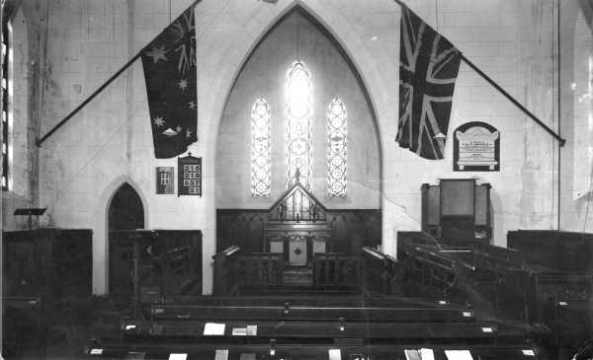There are two historically significant stained glass windows by Ferguson & Urie at Christ Church, Kilmore, Victoria.
The three light chancel window and the “Clifton” memorial window at the liturgical west end are both by the Ferguson & Urie company circa 1864.
The first stone of Christ Church, Kilmore was laid by Bishop Charles Perry on 19th November 1857 and the first service was held in January 1861. The church was consecrated on Monday 20th May 1867 by Bishop Perry.
Photos were taken on 26th December 2011.
Kilmore Free Press & Counties of Bourke & Dalhousie Advertiser, Thursday 23rd May 1867, page 2.
“On Monday Morning His Lordship the Bishop of Melbourne, assisted by the Rev. Mr. Watson, the trustees and church wardens, went through the ceremony of consecrating Christ Church, Kilmore. The affair was conducted in a most solemn manner”.
The following two extracts from the Anglican Church Gazette were kindly provided by Catherine Turnbull, Hon Archivist, Kilmore Anglican Parish, 8th Feb 2011.
The Anglican Church Gazette 1864
“…The chancel windows at once attract attention. The principal devices of the side lights are the ruby crosses on a purple ground, with the leaves and fruit of the vine interspersed, the one having the Scripture words, in Anglo-Saxon letters, “I am the Vine,” the other “Ye are the Branches.” In the centre light, over a beautifully finished head of the Saviour, a dove, emblematic of the Holy Spirit, descends, whilst this is surmounted by the ancient sign of the Trinity, the hexalpha or interlacement of two equilateral triangles. The appearance is very rich and splendid, if not gorgeous, and is highly creditable to the artists, Messrs. Ferguson and Urie. The side windows (seven on each side) are diamond-shaped, lead quarry lights, filled in with muffed glass, the borders being of stained glass of various tints …”
The Anglican Church Gazette, June 16, 1864.
“…A very beautiful Memorial Window has been lately erected in Christ Church, Kilmore. In its general construction it is, as intended, emblematical of sorrow, while a rich golden blue, particularly on a sombre day, pervades it. The centre piece is a light blue cross on a crimson ground, entwined by a wreath, on which is inscribed that well known sentence of the Bible, so comfortable to the Christian, “Blessed are the Dead that die in the Lord.” Over and under this are the family crest and coat of arms, elegantly and conspicuously finished. Underneath is the following inscription annealed in the glass:- “Erected by Wm. Snow Clifton, in memory of his brother, Henry Clifton, who died June 21, 1853, aged 31 years, and was buried in the Kilmore Cemetery. ” The whole is enclosed by a handsome bordering of purple and crimson alternately, with dark leaves between, connected by golden stalks, which form the inner boundary of the border, the outer one being of green. The design and workmanship do great credit to the contractors , Messrs. Ferguson and Urie…”.
Note: There is no known gravestone for Henry Snow Clifton at the Kilmore General Cemetery.
Kilmore Free Press, Vic, Thursday 3rd March 1932, page 2.
(In reference to Christ church, Kilmore)
“…The first place of worship was a building of brick, but as the population was increasing it was deemed imperative that money should be raised to erect a building of much larger and more pretentious character, and the first incumbent the Rev, John Singleton was soon travelling many miles in interviewing squatters and people in outlying parts to collect the necessary money. Soon sufficient funds were in hand to warrant a start with the building which, it was anticipated, would cost some thousands of pounds stirling. The foundation stone was laid by Lord Bishop Perry on the 19th November 1857. The scarcity of funds, however, held up the work from time to time and it was not till 1864 that the church was finished when the Dean of Melbourne, the Rev. Dean Macartney preached the occasional sermon. A writer in the Church gazette of this day states that Christ Church is on an elevated position on the western hill and the style of architecture is English or Lanie of the latter part of the 12th or beginning of the 13th centuries. The architect was a Mr Rudt[1], who gratuitously gave his services. Later the work was carried out by Mr Flury [sic][2], a well known architect of Kilmore. Entering the church the beautiful stained glass windows erected to the memory of loved ones who sleep in that long last sleep command the attention. One is to William Clifton[3] and his brother Henry, the date on which is 1853. It is adorned with the family crest, and bears the motto “Tenez de Droit” [sic] – Hold the Right[4]. This is a very beautiful work of art, and is emblematic of sorrow. The centre piece is a light blue cross on a crimson ground enclosed by a wreath on which is inscribed and appropriate passage of scripture of scripture, and over and under this is the family crest and coat of arms. The designers were Messrs. Fergurson [sic][5] and Urie[6]. “

The Chancel of Christ Church, Kilmore c.1920
William Snow Clifton and his brother Henry Clifton took up the “Arcadia” run[7] in 1848 which was an estimated 80,000 acres along the Goulburn River.
[1] No record of an architect by the name of Rudt. Three architects were involved in Christ Church being W. Z. Perrot, Charles Kingk and James Fleury,
[2] James Fleury – Architect Sydney Street Kilmore.
[3] William Snow Clifton was the donor of the window. Commanding Officer of the Victorian Yeomanry Corps Melbourne circa 1856.
[4] “Tenez le Droit” – French – ‘Uphold the Right’. (The motto used by the Victorian Police Force to this day)
[7] The Melbourne Argus, Vic, Tuesday 25th July 1848, page 1
Short link to this page: https://wp.me/p28nLD-T3